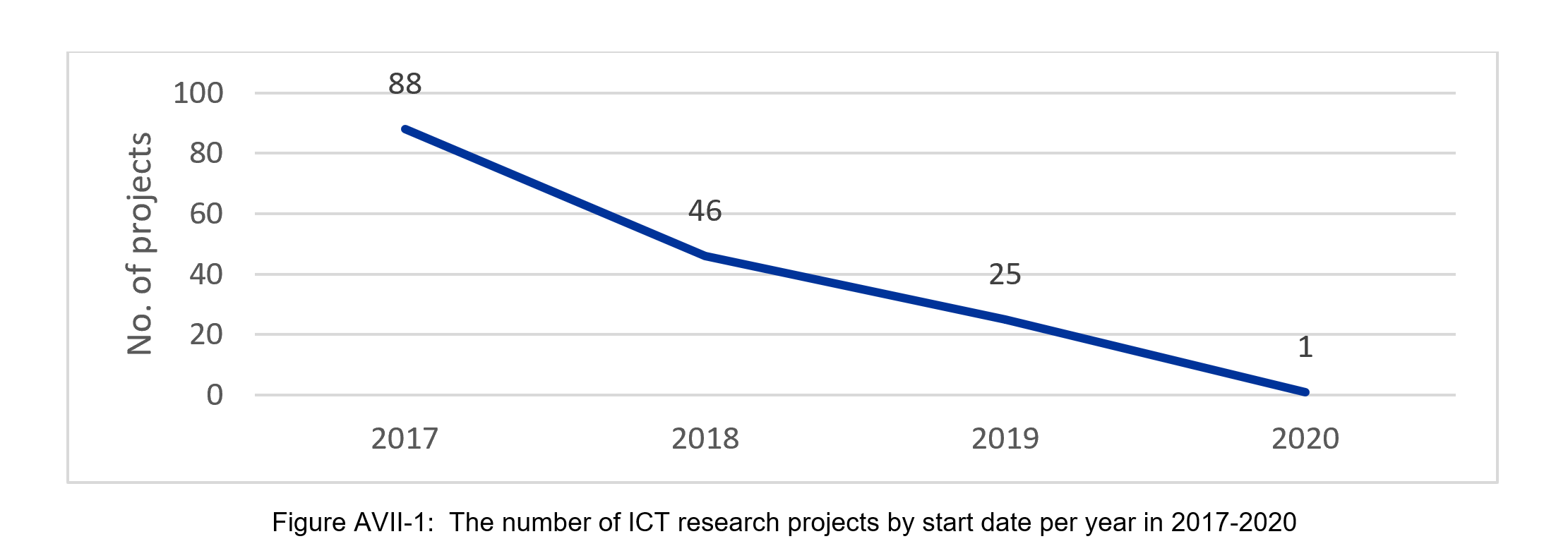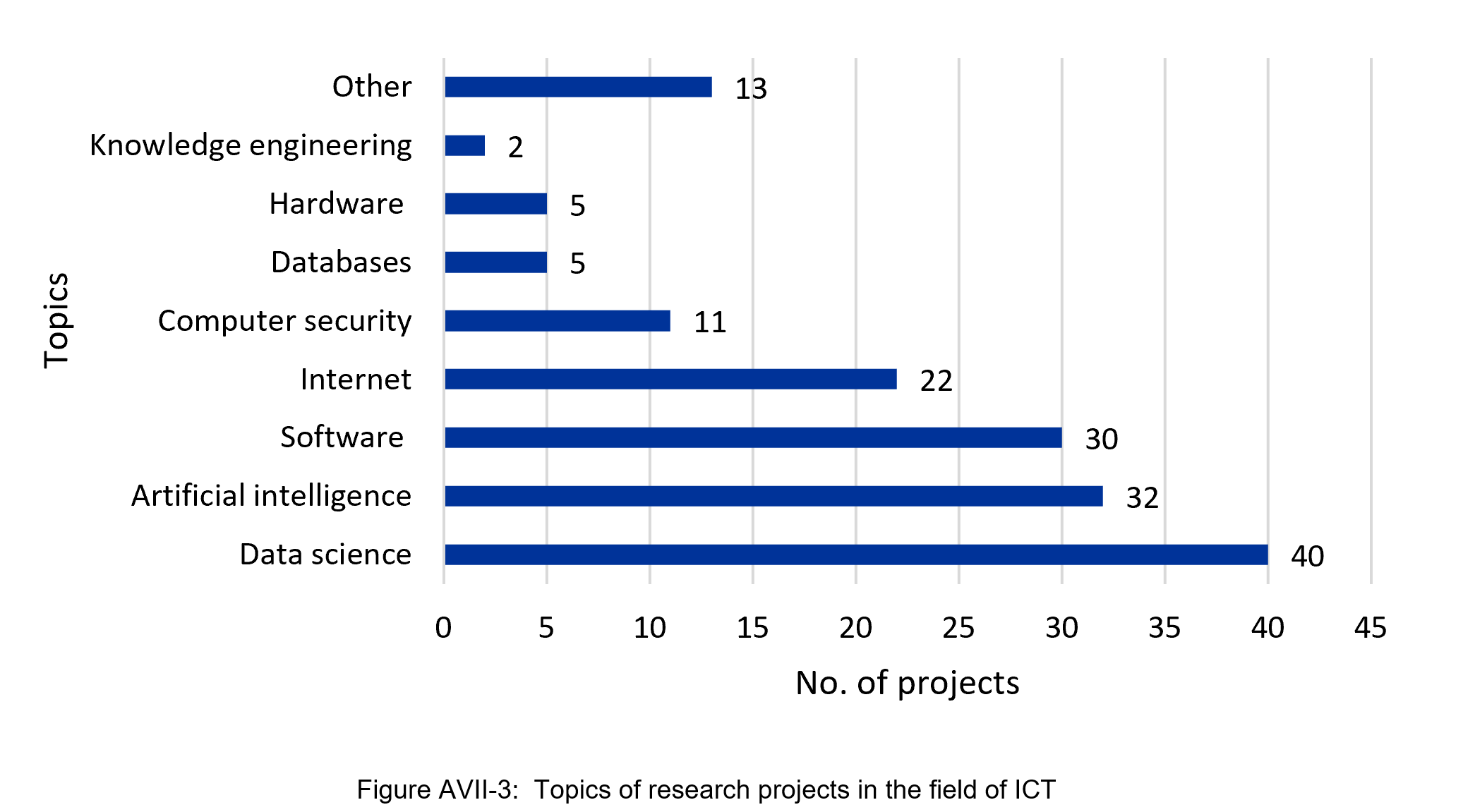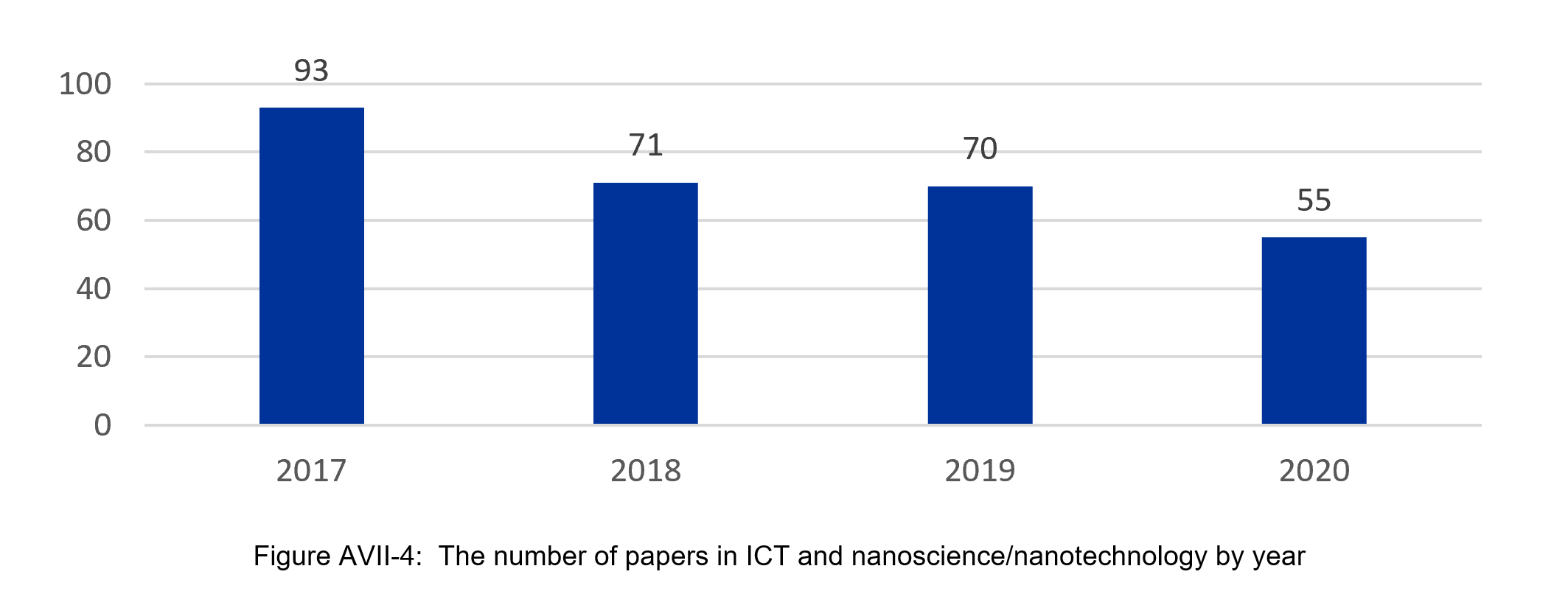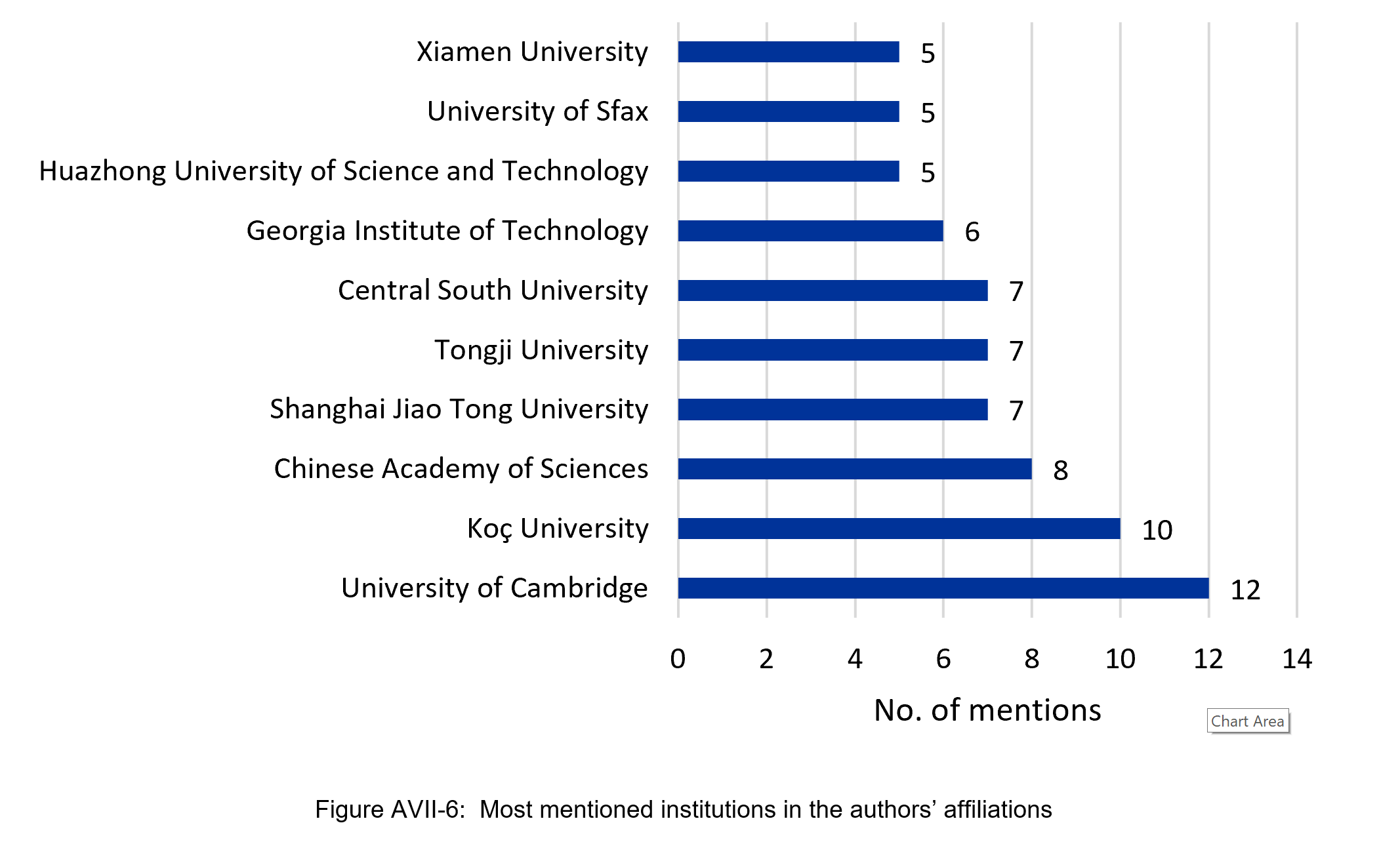R&D - EUON
ICT
Research projects
This section gives an overview of the Horizon 2020 projects focused on ICT. In research classification used by Cordis database, ICT corresponds to the discipline of computer and information sciences.
The projects that contained the keyword “computer and information sciences” in their subject classification were filtered out from the general collection of nanotechnology projects developed for the study.
In the period 2017-2020, Horizon 2020 funded 160 projects in the field of ICT. The ICTprojects comprised 13% of all research projects in nanotechnology funded by the EU in 2017-2020. In general, it shows a moderate interest in ICT and nanotechnology.
Analysis of the start date of ICT projects shows that most of them received funding and started in 2017 and 2018. H2020 covered the 2014-2020 period, so with 2017 as a mid-term of the programme, it is not surprising that most projects started during this period. The decreasing number of research projects towards the end of the funding period is explained by the fact that most research projects require several years to complete.

H2020 contained several high-level programmes/priorities/specific actions and their sub-programmes. Three thematic and two horizontal high-level programmes funded nanotechnology research and innovation:
- Priority “Excellent science” (1) aimed to improve the excellence of the European research base and consolidate the European Research Area (ERA) to increase the global competitiveness of European research and innovation.
- Priority “Industrial leadership” (2) focused on boosting the development of the technologies and innovations that will underpin future businesses and help innovative European SMEs to grow into world-leading companies. This priority contained a sub-programme targeted at nanotechnologies.
- Priority “Societal challenges” (3) focused on the societal challenges that were identified in the Europe 2020 strategy and aimed to encourage sufficient research and innovation efforts necessary to cope with these challenges and achieve the EU strategic goals.
- Specific objective “Spreading excellence and widening participation” (4) was a horizontal objective of Horizon 2020 aimed at pooling research and innovation talents in Europe, nurturing and connecting pools of excellence to maximise and fully exploit Europe’s research and innovation potential.
- Specific objective “Science with and for society” (5) was a horizontal objective of Horizon 2020 aimed at strengthening the collaboration between science and society by engaging citizens in science and using collective intelligence for solving research problems, promoting scientific careers, etc.
Each of the described high-level programmes contained the whole hierarchy of sub-programmes. Usually, one project received funding through a combination of programmes. Those combinations of (sub)programmes in 2017-2020 were filtered out. Figure 9 11 gives an overview of programmes and subprogrammes that funded ICT research under Horizon 2020.

In 2017-2020, Horizon 2020 ICT research projects were more focused on scientific excellence rather than on industrial innovation. Most ICT projects received funding under the priority “Excellent science” and its subprogrammes (75 projects, 47%). These subprogrammes are focused on building the capacity of individual researchers and their teams as well as encouraging collaboration between researchers. Less projects (58, 36%) were funded under the priority “Industrial leadership” that promoted nanotechnology innovation and commercialisation. Twenty-two projects (22, 14%) also focused on the third priority of Horizon 2020 – Societal challenges. Finally, seven projects (4%) were focused on the horizontal objective “Spreading excellence and widening participation” and only 3 projects (2%) – on the horizontal objective “Science with and for society”.
According to the project classification applied in Cordis, construction projects focused on eight topics. One project could combine several topics. In most cases, projects used classes referring to different hierarchical classification levels. For instance, some projects referred to “internet” in general, while others specified the focus on internet of things, etc.

Most projects focused on data science (40 projects, 25%), artificial intelligence (32 projects, 20%), software (30 projects, 19%) and internet (mostly “internet of things”, 22 projects, 14%). Other topics received less attention. An illustrative example of a project focused on the data science is provided in the table below.
| Table AVII-1: An example of a project focused on data science | |||
|---|---|---|---|
| Project title, acronym, (coordinating country) |
Objectives | Start, end dates | Funding (EU contribution) |
| Innovative Nanowire DEvicE Design, INDEED (UK) |
Nanowires (NWs) exhibit unique properties that make them potential building blocks for a variety of next generation NanoElectronics devices. Recent advances have shown that NWs with predefined properties can be grown, offering a new paradigm enabling functional device prototypes including: biosensors, solar cells, transistors, quantum light sources and lasers. The critical mass of scientific knowledge gained now needs to be translated into NW technologies for industry. FP7-MC NanoEmbrace (ITN) and FUNPROB (IRSES), made substantial contributions to NW research, producing excellent scientific and technological results (>100 journal papers published) and delivered outstanding training in nanoscience and transferable skills to ESRs. Despite demonstrable scientific and technological advantages of NWs, NW-based technology concepts have not yet been translated into market-ready products, because industry and academia have not worked hand-in-hand to commercialize the research findings. Thus, it is essential that NW research is now directed towards customer-oriented scientific R&D; whilst applying innovative industrial design techniques to ensure rapid translation of the basic technologies into commercial devices. This ambitious challenge requires close collaboration between academia and the nascent NW industry, combining the efforts of scientists and engineers to address market needs. Building upon our previous achievements, a team of leading scientific experts from top institutions in Europe, strengthened by experts in innovative design and industrial partners with an excellent track record of converting cutting edge scientific ideas into market products has formed the INDEED network to address this challenge. To enhance employability, INDEED will train young ESRs to become experts with a unique skill set that includes interdisciplinary scientific techniques, industrial experience through R&D secondments and innovative design skills. |
2017-2021 | € 4 000 457,52 |
Scientific publications
In the period 2017-2020, 289 papers in information and computing sciences and nanotechnology/nanoscience were published in the forty journals of the first and second quartiles selected for this research. The number of papers in 2017-2020 has been decreasing from 93 publications in 2017 to 55 – in 2020.

The publishing pattern of scientific publications in 2017-2020 shows a modest research interest in nanotechnology applications in the ICT sector.
All papers were published in two journals: IEEE Transactions on NanoBioscience and IEEE Nanotechnology Magazine, both belonging to the second quartile under the subject heading of Nanoscience/nanotechnology. IEEE Transactions on NanoBioscience focuses on the interdisciplinary research in nano- and micro-scale biological systems. Among other topics it invites the research submissions on information storage and processing, which is of interest to the ICT researchers. IEEE Nanotechnology Magazine invites the research on a wide range of nanotechnology and nanoscience topics. Both journals are published by the Institute of Electrical and Electronics Engineers (IEEE, USA).
The scientific papers in the field of health were authored by 1283 scholars from 45 countries. Most papers were authored by multiple researchers that in many cases represented international teams. Therefore, the study team analysed mentions of country in each author’s affiliation record. Figure AVII-5 provides an overview of the ten most mentioned countries in the affiliation of authors.

Analysis of countries in affiliations of the authors revealed that most authors represented China (179) and United States of America (93).
Furthermore, analysis of researchers’ affiliation institutions showed the prevalence of Chinese research and higher education institutions in the list of top ten organisations quoted in authors’ data.

However, the top mentioned institution in the authors’ affiliation data is University of Cambridge (USA) and Koc University is a private higher education institution in Turkey.
Scientific breakthroughs
A scientific breakthrough is a research publication that has a substantial impact on the further research of the issue addressed in such paper. The study uses the scientometric approach that develops and applies quantitative measures to analyse patterns in scholarly communication for identifying breakthrough publications. Scientific breakthroughs were identified by analysing the number of citations, the share of recent citations and the number of different research fields in the citation data of the paper.
The research identified one ICT publication that met the criteria for scientific breakthroughs. The paper addressed a research issue on the intersection of medical sciences and the protection of personal data transferred through the digital channels.
| Table AVII-2: Scientific breakthroughs in the field of health | ||||
|---|---|---|---|---|
| Bibliographic data | Citations | Recents citations | Citing FORs* | Altmetric score |
| Ravichandran, D., Praveenkumar, P., Rayappan, J. B. B., & Amirtharajan, R. (2017). DNA chaos blend to secure medical privacy. IEEE transactions on nanobioscience, 16(8), 850-858. | 105 | 66 | 8 | No data |
| NOTE: *FORs - Fields of Research | ||||


